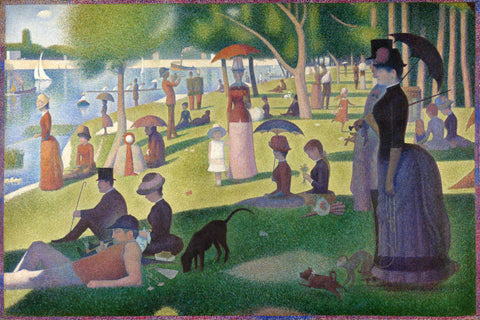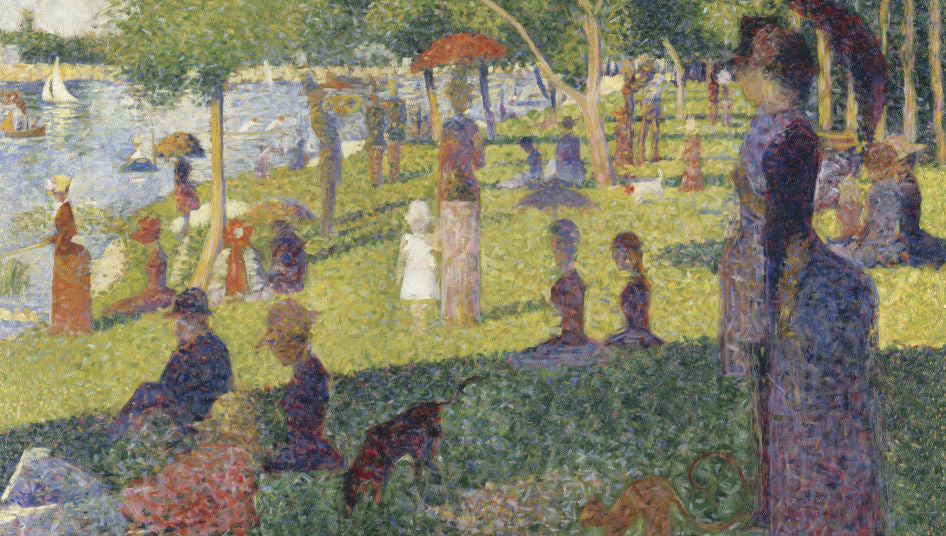Table of Contents:[hide]
Unveiling the Masterpieces: The Life and Artistry of Georges Seurat
Georges Seurat, a pioneer of the Pointillist movement, left an indelible mark on the art world with his innovative approach to painting. Born on December 2, 1859, in Paris, Seurat's life and works continue to captivate art enthusiasts around the globe. In this article, we delve into the fascinating journey of Georges Seurat, exploring his life, artistic vision, and the timeless legacy of his iconic paintings.
Early Life and Education
Georges Seurat's journey into the world of art began in Paris, where he was born to a well-to-do family. His early years were marked by a deep fascination with drawing, a passion that would shape his destiny. Seurat's formal art education started at the École des Beaux-Arts, a renowned institution that laid the foundation for his artistic prowess.
Despite his traditional arteducation, Seurat was drawn to unconventional techniques and styles. He sought inspiration from diverse sources, paving the way for the evolution of his distinctive artistic vision.
The Birth of Pointillism
In the late 19th century, Seurat co-founded the Société des Artistes Indépendants, a group committed to breaking away from traditional artistic norms. It was during this time that he introduced the world to Pointillism, a groundbreaking technique that relied on the meticulous placement of individual dots to form a cohesive image.
Pointillism, also known as Divisionism, was a departure from the prevailing artistic methods of the time. Seurat's innovative approach involved the use of small, distinct dots of color that, when viewed from a distance, blended harmoniously to create a vibrant and unified image. This technique marked a revolutionary shift in the art world and solidified Seurat's status as a trailblazer.
Masterpieces and Influences

Seurat's most famous work, "A Sunday Afternoon on the Island of La Grande Jatte" (1884-1886), stands as a testament to the artist's mastery of Pointillism. This monumental painting, set in a Parisian park, captures the essence of leisure and society in a meticulous display of color and light. The intricate details and meticulous application of dots showcase Seurat's dedication to his craft.
The influence of Impressionism, particularly the works of artists like Claude Monet and Camille Pissarro, can be traced in Seurat's early pieces. However, as he delved deeper into Pointillism, Seurat carved a niche for himself, elevating his art to new heights.
Personal Life and Challenges
Despite his artistic success, Seurat faced personal challenges throughout his life. His meticulous and time-consuming painting technique, coupled with his dedication to perfection, often led to prolonged periods of artistic gestation. This commitment to detail contributed to a relatively small body of work, but each piece was a testament to Seurat's unwavering dedication to his craft.
Tragically, Seurat's life was cut short when he succumbed to illness at the age of 31. His untimely death left the art world mourning the loss of a visionary artist who had only just begun to explore the depths of his creativity.

Legacy and Impact
Georges Seurat's impact on the art world extended far beyond his lifetime. The Pointillist movement, pioneered by Seurat, inspired a generation of artists who sought to break free from the constraints of traditional techniques. Artists like Paul Signac, who collaborated closely with Seurat, carried the torch forward, ensuring the longevity of Pointillism as a significant artistic movement.
Seurat's influence also extended to other forms of art, including literature and music. His ability to convey emotion and atmosphere through the careful arrangement of color dots left an indelible mark on the broader cultural landscape.
FAQs About Georges Seurat
Q1: What is Pointillism, and how did Georges Seurat contribute to it?
A1: Pointillism is a painting technique where small, distinct dots of color are applied in patterns to form an image. Georges Seurat, a French artist, is considered the pioneer of Pointillism. He developed this technique, also known as Divisionism, and applied it meticulously to create harmonious and vibrant compositions.
Q2: What are some key characteristics of Georges Seurat's style?
A2: Georges Seurat's style is characterized by the use of Pointillism, where he employed tiny dots of color to create intricate and detailed compositions. His works often featured scenes of everyday life, and he was known for his meticulous attention to color theory and light.
Q3: Which is Georges Seurat's most famous painting, and why is it significant?
A3: "A Sunday Afternoon on the Island of La Grande Jatte" is Georges Seurat's most famous painting. Created between 1884 and 1886, this masterpiece is significant for its revolutionary use of Pointillism, capturing a leisurely scene in a Parisian park with meticulous detail and precision.
Q4: What influences shaped Georges Seurat's artistic vision?
A4: Georges Seurat was initially influenced by Impressionism, particularly the works of Claude Monet and Camille Pissarro. However, he later developed his distinctive style, Pointillism, which was influenced by scientific theories of color and light, as well as his desire to move away from traditional artistic norms.
Q5: How did Georges Seurat's life impact the art world after his death?
A5: Despite his relatively short life, Georges Seurat's impact on the art world was profound. The Pointillist movement he pioneered continued to inspire artists, and his innovative techniques influenced various art forms, leaving a lasting legacy that shaped the course of modern art.
Conclusion
Georges Seurat's life and paintings remain a captivating chapter in the annals of art history. From his early exploration of drawing to the revolutionary Pointillist masterpieces, Seurat's journey reflects an unwavering commitment to artistic innovation. As we continue to admire the timeless allure of his paintings, it becomes clear that Georges Seurat's legacy is not just a historical footnote but a vibrant and enduring testament to the transformative power of art.
Georges Seurat Prints
Georges Seurat List of Paintings
1. Angélique (1878)
2. Landscape at Saint-Ouen (1878 or 1879)
3. Head of a Young Girl (1879)
4. Paysage rose (1879)
5. Vase of Flowers (1879 to 1881)
6. Sunset (1881)
7. Landscape with "The Poor Fisherman" by Puvis de Chavannes (1881)
8. The Mower (1881 to 1882)
9. A man leaning against a Parapet (1881 to 1882)
10. Trees on the river bank (1881 to 1882)
11. The Forest at Pontaubert (1881)
12. Peasants Driving Stakes (1882)
13. Field in Barbizon (1882)
14. Forest in Barbizon (1882)
15. Summer (1882)
16. Forest at sunset (1882)
17. Grassy river bank (1882)
18. Landscape with a stake (1882)
19. Peasant with a Hoe (1882)
20. Boy sitting in a meadow (1882 to 1883)
21. Le Petit Paysan en bleu (1882)
22. Massive figure in a meadow in Barbizon (1882)
23. Farm Women at Work (1882 to 1883)
24. House and Garden (1882 to 1883)
25. White houses in Ville d'Avray (1882 to 1883)
26. Landscape in the Île-de-France (1882 to 1883)
27. Man with a Hoe (1882 to 1883)
28. The Stone breaker (1882 to 1883)
29. Topless Stonebreaker (1882 to 1883)
30. Stonebreaker From the Back (1882 to 1883)
31. The Stone Breakers, Le Raincy (1882)
32. Three Stonebreakers (1882 to 1883)
33. Two stonebreakers (1882 to 1883)
34. Haymakers at Montfermeil (1882)
35. The Stone Breaker (1882)
36. The Gardener (1882 to 1883)
37. Peasant with Hoe (1882)
38. Haystacks (1882 to 1883)
39. View of the Seine (1882 to 1883)
40. Stonebreaker (1882 to 1883)
41. Landscape near Paris (1883)
42. Peasant Woman Seated in the Grass (1883)
43. Two Stonebreakers (1883)
44. Farmer at work (1883)
45. Horse with carriage in a meadow (1883)
46. The team (1883)
47. Cow in the pasture (1883)
48. Cows in a meadow (1883)
49. Figures in a Landscape (1883)
50. A Summer Landscape (1883)
51. Arbres, hiver (1883)
52. Lisière de bois au printemps (1883)
53. The Seine at Courbevoie (1883 to 1884)
54. Around the Town (1883)
55. House with a red roof (1883)
56. Houses between trees (1883)
57. Watering can at Le Raincy (1883)
58. Suburb (1883)
59. Snow Effect (1883)
60. Figures on a street (1883)
61. Man painting a boat (1883)
62. Man in a boat (1883)
63. A Fisherman (1883)
64. Banks of the Seine near Courbevoie (1883)
65. Allée en forêt, Barbizon (1883)
66. A River Bank (The Seine at Asnières) (1883)
67. Houses on the banks of the Seine (1883)
68. Boat by the Bank, Asnieres (1883)
69. Fishermen on the banks of the Seine (1883)
70. Banks of the Seine (1883)
71. Horse and Boats (1883)
72. White horse and black horse in the water (1883)
73. Bathers (1883)
74. The Rainbow (1883)
75. Sitting Man on the Banks of the Seine (1883)
76. Five Male Figures (1883)
77. Clothes on the Grass (1883)
78. The Seine with Clothing on the Bank (1883)
79. Boy with Horse near Asnières (1883)
80. Figure on the banks of the Seine and bathers (1883)
81. Bathers sitting on the Beach of the Seine (1883)
82. Final Study for "Bathers at Asnières" (1883)
83. Bathers at Asnières (1884)

